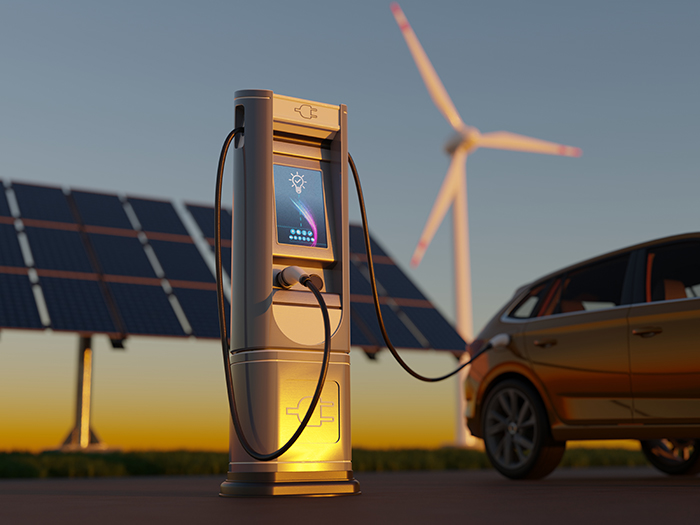Surge in Renewable Energy Investment: Navigating Risks with Solar and EV Charging Stations – Workers Comp Forum
The increased adoption of renewable energy technologies, particularly EV charging stations and solar panels, means it’s time for a risk review. Best practices for installation and upkeep start with having the right partner in place.
The push to use renewable energy resources is growing each day as wind turbines rise, solar panels soak up the sun and electric vehicles (EVs) hit the road.
“The renewable energy sector in the United States is growing at a remarkable pace, surpassing initial projections,” said Stacie Prescott, energy underwriting officer, The Hartford. “According to information released by MIT, efficiency gains in existing technologies, such as improved solar panels and various types of batteries, are driving this growth.
“In fact, the U.S. saw a staggering $1.7 trillion of investment in renewable energy in 2023 — including renewable power, nuclear, grids, storage, low-emission fuels, efficiency improvements and end-use renewables and electrification — outpacing any other country globally,” Prescott continued, citing an IEA report. “In comparison, fossil fuel investment, primarily in coal, oil and gas, stood at only $1 trillion, for a ratio of 1.7 to 1; five years ago, this ratio was 1 to 1. This highlights the scale of growth and incentives in the renewable energy sector across various sources.” 1
This commitment to renewable energy has many businesses and individuals adding new technologies to their existing power systems. Interest in EVs and solar panels — specifically solar photovoltaic (PV) systems — is on the rise, and each individual component has its own set of risks that must be addressed.
Luckily, The Hartford has researched each of them to better understand what risk management strategies should come into play.
EV Charging Stations: A Risk Overview

Stacie Prescott, Energy Underwriting Officer, The Hartford
More EVs are on the road than ever before; one report stated that over 2.4 million electric vehicles were registered in the U.S. in 2022.
These vehicles are in homes, shopping centers, public garages, workplaces and more. Keeping them charged is key for operators, and as Consumer Affairs reported, between 2018 and 2023, the number of charging stations nationwide more than doubled, increasing from 22,826 stations to 64,187. 2
With so many EV charging stations cropping up, risk review is paramount.
Perhaps the most prominent risk associated with EV charging stations is the potential for fires: “When it comes to EV charging stations, it’s not just the chargers themselves that are a concern but also the design of the station and the vehicles being charged,” Prescott said.
It’s important to remember that existing infrastructure was not built with EV charging stations in mind, and therefore, when looking to add more stations, existing parking structures may not have the proper space for them. Putting EV charging units too close together, or too close to cars, can increase the risk of fire or electrical damage.
The good news is that today’s battery energy storage systems, or BESS, have come a long way since about decade ago. Where once these early systems used more hazardous types of lithium-ion batteries prone to thermal runaway and fires, today’s BESS are better-suited to handle the energy load.
“With EV charging, the main concern is the lithium-ion batteries in the vehicles being charged, rather than the charging equipment itself,” added Kenneth Travers, technical manager, property risk engineering, The Hartford.
“There are also potential liability exposures, such as electrocution if proper grounding is not in place, or if combustibles are located too close to the charger, potentially leading to a fire if a short circuit occurs.”
Further, many of these EV charging stations are placed in areas that are not actively monitored, like unattended garages or outdoor parking lots. Lack of surveillance can lead to damage or theft. Vandalism is another area that has resulted in losses for EV charging stations due to the valuable copper wiring used within.
Additional Rooftop Solar PV Risks

Kenneth Travers, Technical Manager, Property Risk Engineering, The Hartford
For solar PV systems, which are often installed on rooftops, fire remains a prominent issue as well.
“Firefighters face significant challenges when dealing with fires in PV systems installed on rooftops of buildings,” Travers said.
That is because “fires have occurred due to mismatched or improper connectors used to connect the panels to the inverters. The combustible insulation and roof coverings beneath the panels can also contribute to fire spread in the building below.”
Another risk associated with solar PV systems is the risk of electrocution. For example, firefighters responding to an incident may be hesitant to deploy personnel on the roof until the power to the panels is shut off, due to the risk of electrocution.
Tight rows that limit mobility around rooftop panels, as well as the power source’s location (in the center versus at the edge of the panels), can also increase the risk of electrocution.
“Additional perils for PV systems include hail damage, and flooding of ground-mounted inverters and controllers,” Travers added.
Incorporating Best Practices
In order to prevent the risk of fire, electrocution, theft and more, best practices must be followed when installing and maintaining these renewable energy technologies.
It starts as early as the planning phase.
“The Hartford has developed a standard for charging stations in new construction or when installing new components in existing buildings. We ask clients to maintain certain spacing between chargers to force the spacing of EVs, as that’s the primary spot where we’re worried about a fire initiating,” Travers explained.
This standard applies not only to passenger sedans but also to vans and larger trucks. Many electric buses have battery energy storage systems on either the roof or the back end of the engine compartment, up to six storage units per bus.
“There have been numerous bus fires related to this,” Travers said. “To prevent the transfer of fire from one bus to another or to sections of the building, we provide guidance on spacing these vehicles inside bus garages.”
For solar panels, The Hartford team suggests installing power disconnects at both the roof and ground levels. This allows fire departments to quickly shut off power from the ground before deploying personnel to the roof.
“We also pay attention to the materials used in the PV panels and frames. Some manufacturers, particularly those from Asia, may use combustible plastic frames or backing sheets, which can increase the fire load on the roof. In such cases, we recommend replacing these components with non-combustible alternatives,” Travers said.
Once panels have been added to a structure, regular maintenance and inspections by reputable authorities — such as the North American Board of Certified Energy Practitioners — goes a long way in preventing risk.
Finding Your Ideal Renewable Underwriting Partner
EV charging stations and solar PV systems are equipped with relatively new technologies, which means there isn’t extensive loss history available on them. Underwriting these risks requires a deep understanding of the nuances surrounding such tech features.
“Underwriting risks in the rapidly evolving renewable energy industry can be challenging, as the industry is often one step ahead of insurers in terms of new exposures,” said Prescott.
She gave the example of an untrained individual purchasing an electric vehicle charger online and installing it themselves.
“As underwriters, we must learn from experience and adapt to these emerging risks as they arise. While it’s an exciting challenge, it often means we have to learn as we go when it comes to understanding and effectively underwriting these new exposures in the renewable energy sector,” she said.
Luckily, underwriters at The Hartford have a robust set of standards when it comes to renewable energy structures. Backed by a team of risk engineering professionals who help the underwriters evaluate the specific risks associated with each individual installation, The Hartford is able to provide for and work with its clients on top safety measures and best practices.
“We have a strong risk engineering team that works closely with underwriters to assess and mitigate risks. While battery storage initially posed some challenges due to thermal runaway issues, we’ve learned to underwrite the surrounding exposures effectively. Our comfort level with solar and wind is well-established,” said Travers.
“The main challenge now is keeping pace with the rapid improvements and efficiencies in these technologies,” he added. “I’m confident that with the support of our risk engineering team and the wealth of data we possess, The Hartford can quickly adapt to underwrite these emerging risks effectively.”
To learn more, visit: https://www.thehartford.com/business-insurance/renewable-energy.
1 Source: Overview and key findings – World Energy Investment 2023 – Analysis – IEA
2 Source: How Many EV Charging Stations Are in the U.S.? 2024, Consumer Affairs, February 20, 2024
The information provided in these materials is intended to be general and advisory in nature. It shall not be considered legal advice. The Hartford does not warrant that the implementation of any view or recommendation contained herein will: (i) result in the elimination of any unsafe conditions at your business locations or with respect to your business operations; or (ii) be an appropriate legal or business practice. The Hartford assumes no responsibility for the control or correction of hazards or legal compliance with respect to your business practices, and the views and recommendations contained herein shall not constitute our undertaking, on your behalf or for the benefit of others, to determine or warrant that your business premises, locations or operations are safe or healthful, or are in compliance with any law, rule or regulation. Readers seeking to resolve specific safety, legal or business issues or concerns related to the information provided in these materials should consult their safety consultant, attorney or business advisors. All information and representations contained herein are as of June 2024.
Links from this site to an external site, unaffiliated with The Hartford, may be provided for users’ convenience only. The Hartford does not control or review these sites nor does the provision of any link imply an endorsement or association of such non-Hartford sites. The Hartford is not responsible for and makes no representation or warranty regarding the contents, completeness or accuracy or security of any materials on such sites. If you decide to access such non-Hartford sites, you do so at your own risk.
![]()
This article was produced by the R&I Brand Studio, a unit of the advertising department of Risk & Insurance, in collaboration with The Hartford. The editorial staff of Risk & Insurance had no role in its preparation.
The Hartford is a leader in property and casualty insurance, group benefits and mutual funds. With more than 200 years of expertise, The Hartford is widely recognized for its service excellence, sustainability practices, trust and integrity.


